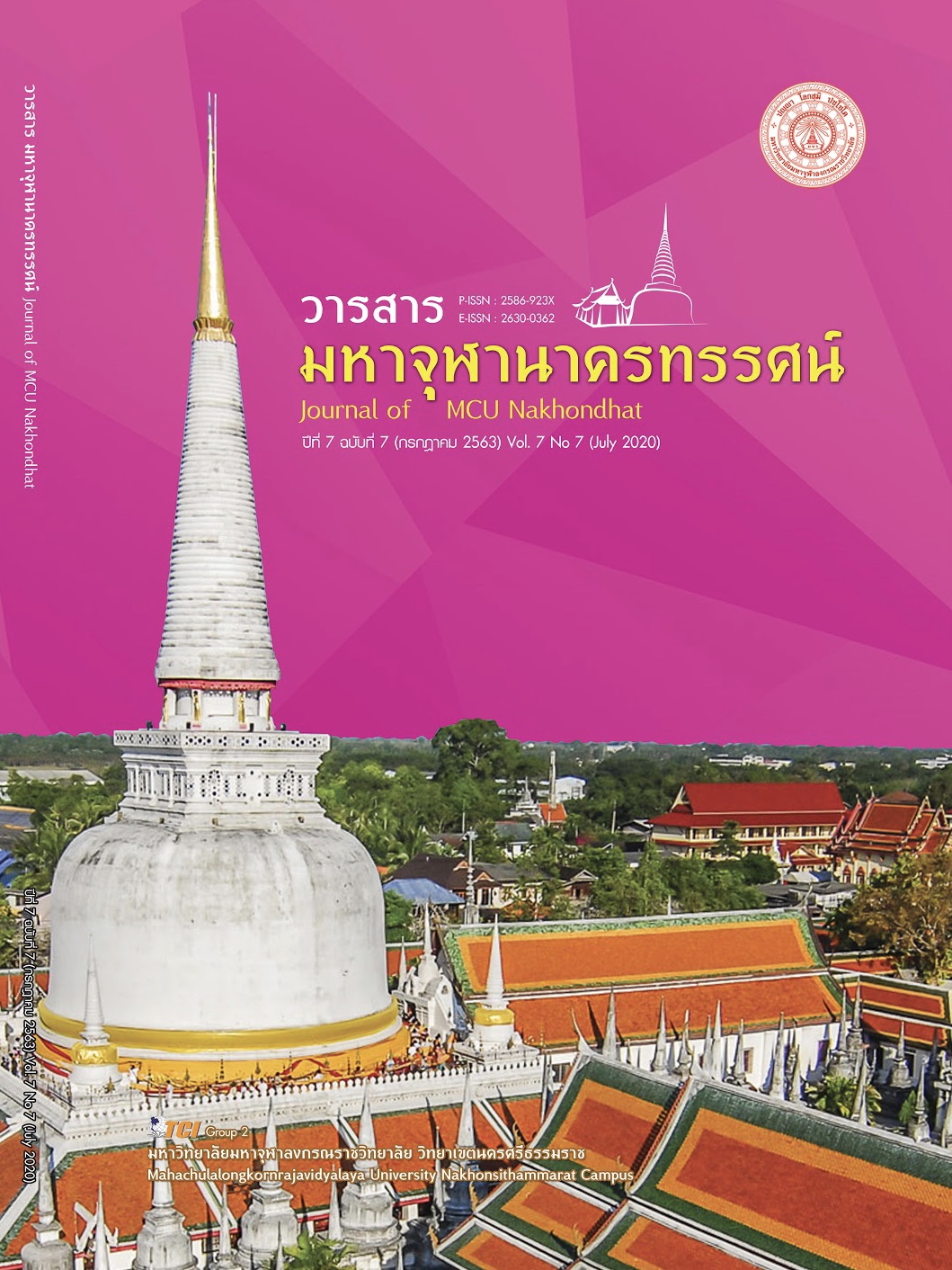การพัฒนาแนวทางการจัดการความขัดแย้งในสถานศึกษา สังกัดสำนักงานเขตพื้นที่การศึกษาประถมศึกษาบุรีรัมย์ เขต 2
Main Article Content
บทคัดย่อ
บทความนี้มีวัตถุประสงค์คือ 1) เพื่อศึกษาสภาพปัญหาความขัดแย้งในสถานศึกษา สังกัดสำนักงานเขตพื้นที่การศึกษาประถมศึกษาบุรีรัมย์ เขต 2 2) เพื่อพัฒนาแนวทางการจัดการความขัดแย้งในสถานศึกษา สงกัดสำนักงานเขตพื้นที่การศึกษาประถมศึกษาบุรีรัมย์ เขต 2 แบ่งเป็น 2 ระยะ ดังนี้ ระยะที่ 1 การศึกษาสภาพปัญหาความขัดแย้งในสถานศึกษา กลุ่มตัวอย่างที่ใช้ในการวิจัย จำนวน 357 คน เครื่องมือที่ใช้ ได้แก่ แบบสอบถามแบบมาตราส่วนประมาณค่า 5 ระดับ ระยะที่ 2 การพัฒนาแนวทางการจัดการความขัดแย้งในสถานศึกษา สังกัดสำนักงานเขตพื้นที่การศึกษาประถมศึกษาบุรีรัมย์ เขต 2 กลุ่มผู้ให้ข้อมูล ได้แก่ ผู้บริหาร มีผลการปฏิบัติงานที่เป็นเลิศ จำนวน 3 คน ซึ่งได้มาโดยการเลือกแบบเจาะจง เครื่องมือที่ใช้ ได้แก่ แบบสัมภาษณ์ และแบบประเมินความเหมาะสมและความเป็นไปได้ สถิติที่ใช้ในการวิเคราะห์ข้อมูล ได้แก่ ร้อยละ ค่าเฉลี่ย และส่วนเบี่ยงเบนมาตรฐาน
ผลการวิจัยพบว่า: 1) ผลการศึกษาสภาพปัญหาความขัดแย้งในสถานศึกษา สังกัดสำนักงานเขตพื้นที่การศึกษาประถมศึกษาบุรีรัมย์ เขต 2 พบว่า มีค่าเฉลี่ยอยู่ในระดับน้อย เมื่อพิจารณาพบว่า ความขัดแย้งภายในองค์กร และความขัดแย้งระหว่างกลุ่ม อยู่ในระดับปานกลาง ความขัดแย้งภายในกลุ่ม และความขัดแย้งภายในบุคคล อยู่ในระดับน้อย และ ความขัดแย้งระหว่างบุคคล อยู่ในระดับน้อยที่สุด เรียงลำดับตามค่าเฉลี่ยจากมากไปน้อยได้ดังนี้ ลำดับที่ 1 ความขัดแย้งภายในองค์กร ลำดับที่ 2 ความขัดแย้งระหว่างกลุ่ม ลำดับที่ 3 ความขัดแย้งภายในบุคคล ลำดับที่ 4 ความขัดแย้งภายในกลุ่ม และลำดับที่ 5 ความขัดแย้งระหว่างบุคคล 2) ผลการประเมินแนวทางการจัดการความขัดแย้งในสถานศึกษา สังกัดสำนักงานเขตพื้นที่การศึกษาประถมศึกษาบุรีรัมย์ เขต 2 พบว่า โดยรวมมีความเหมาะสมอยู่ในระดับมากที่สุด และความเป็นไปได้อยู่ในระดับมาก
Article Details
เอกสารอ้างอิง
เสริมศักดิ์ วิศาลาภรณ์. (2540). ความขัดแย้ง การบริหารเพื่อความสร้างสรรค์. (พิมพ์ครั้งที่ 2). กรุงเทพมหานคร: ต้นอ้อ แกรมมี่.
กาญจนา แก้วพล. (2560). การพัฒนาแนวทางการจัดการความขัดแย้งในสถานศึกษา สังกัดสำนักงานเขตพื้นที่การศึกษาประถมศึกษาหนองคาย เขต 2. ใน วิทยานิพนธ์การศึกษาศาสตรมหาบัณฑิต สาขาวิชาการบริหารการศึกษา. มหาวิทยาลัยมหาสารคาม.
จิตราพัชร์ ชัยรัตนหิรัญกุล. (2556). การศึกษาการจัดการความขัดแย้งในสถานศึกษาของผู้บริหารโรงเรียนสำนักงานเขตพื้นที่การศึกษามัธยมศึกษาเขต 42. วารสารวิชาการเครือข่ายบัณฑิตศึกษา มหาวิทยาลัยราชภัฏภาคเหนือ, 3(5), 137-152.
ณรงค์ กังน้อย. (2545). ยุทธวิธีจัดการกับความขัดแย้งของผู้บริหารโรงเรียนสังกัดสำนักงานการประถมศึกษาจังหวัดสุพรรณบุรี. ใน วิทยานิพนธ์ครุศาสตรมหาบัณฑิต สาขาวิชาการบริหารการศึกษา. สถาบันราชภัฏนครปฐม.
บุญชม ศรีสะอาด. (2556). การวิจัยเบื้องต้น. (พิมพ์ครั้งที่ 9). กรุงเทพมหานคร: สุวีริยาสาส์น.
บุญมั่น ธนาศุภวัฒน์. (2537). จิตวิทยาองค์การ. กรุงเทพมหานคร: โอ.เอส.พรินติ้ง เฮ้าส์.
ประภาทิพย์ ผาสุก. (2551). การจัดการความขัดแย้งของผู้บริหารสถานศึกษา สังกัดสำนักงานเขตพื้นที่การศึกษา ลำพูน เขต 1. ใน วิทยานิพนธ์การศึกษาศาสตรมหาบัณฑิต สาขาวิชาการบริหารการศึกษา. มหาวิทยาลัยเชียงใหม่.
สุธาทิพย์ นิยม. (2556). การศึกษาสาเหตุความขัดแย้ง การจัดการความขัดแย้ง และแนวทางจัดการ ความขัดแย้งของผู้บริหารสถานศึกษา สังกัดสำนักงานเขตพื้นที่การศึกษาประถมศึกษาอุดรธานี เขต 4. ใน วิทยานิพนธ์การศึกษามหาบัณฑิต สาขาวิชาการบริหารการศึกษา. มหาวิทยาลัยมหาสารคาม.
สุวิทย์ บัวกอง. (2559). การบริหารความขัดแย้งในสถานศึกษาขั้นพื้นฐาน กลุ่มโรงเรียนดงขุยสังกัดสำนักงานเขตพื้นที่การศึกษาประถมศึกษาเพชรบูรณ์ เขต 1. ใน วิทยานิพนธ์ศึกษาศาสตรมหาบัณฑิต สาขาวิชาการบริหารการศึกษา. วิทยาลัยนครราชสีมา.
อาวุธ โอชาพงษ์. (2547). ความพึงพอใจของครูต่อวิธีการแก้ปัญหาความขัดแย้งของผู้บริหารสถานศึกษา สังกัดสำนักงานคณะกรรมการการศึกษาขั้นพื้นฐานจังหวัดชลบุรี. ใน วิทยานิพนธ์ครุศาสตรมหาบัณฑิต สาขาวิชาการบริหารการศึกษา. มหาวิทยาลัย ราชภัฏราชนครินทร์.


